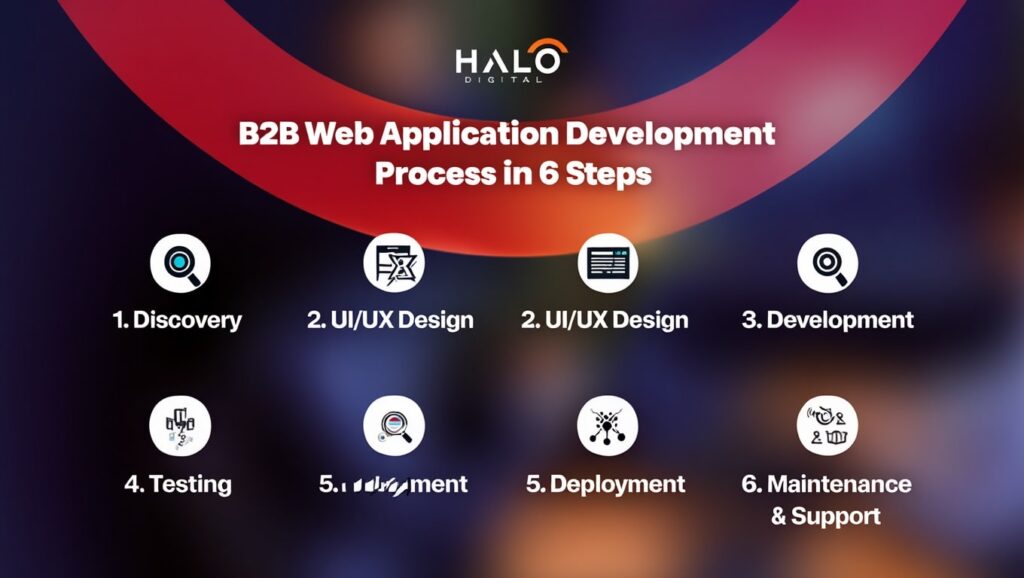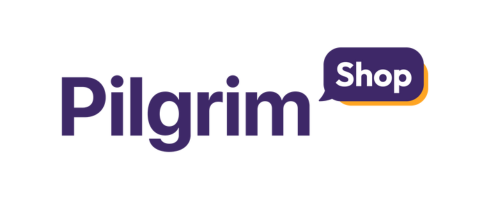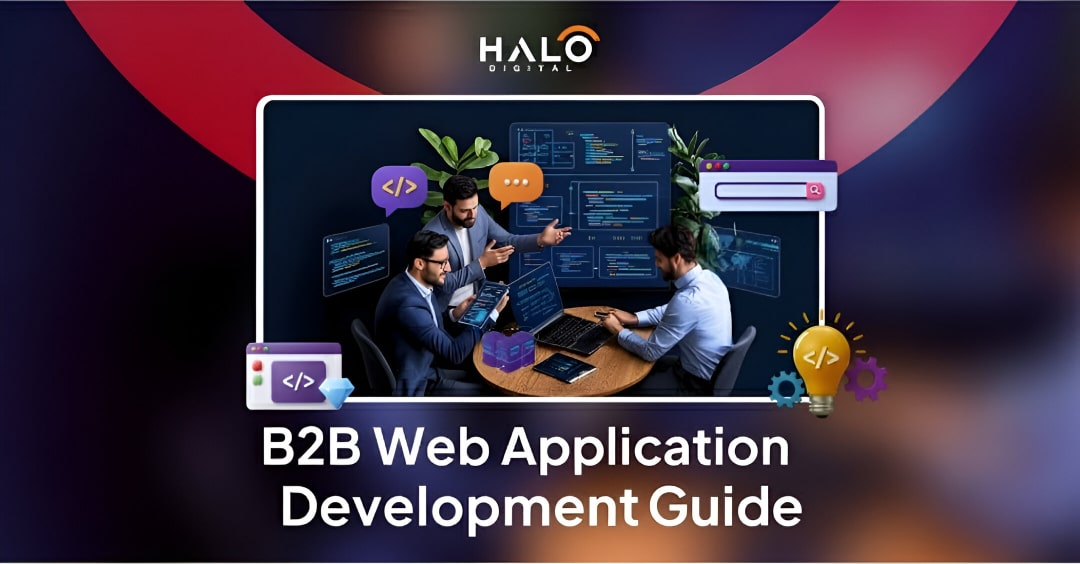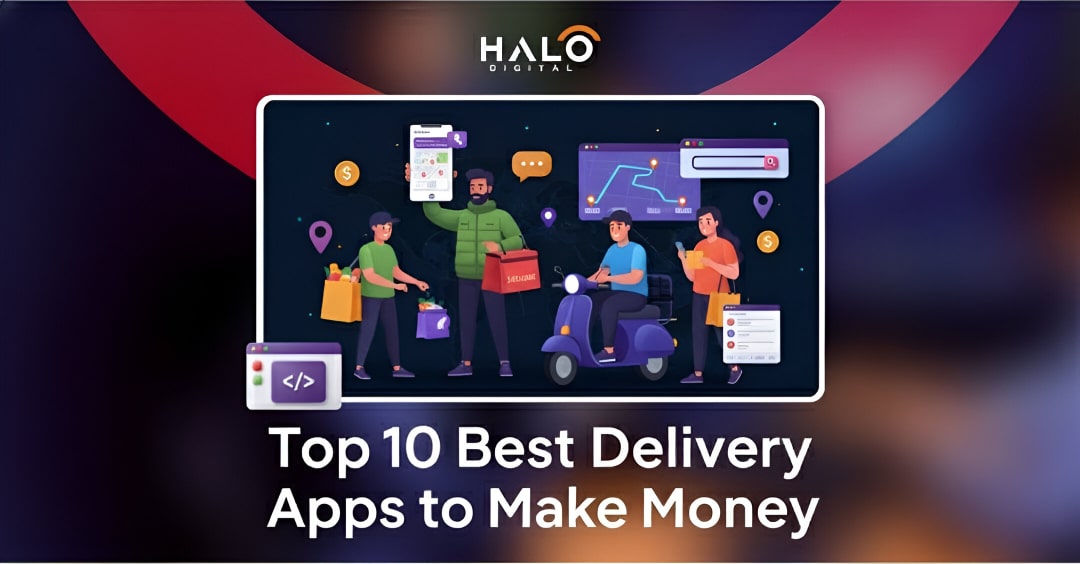- Modern web applications eliminate slow, error-prone manual work by automating critical business processes.
- Centralized systems improve collaboration and reduce confusion caused by scattered files or disconnected tools.
- Strong security frameworks protect sensitive data and help maintain compliance across industries.
- Scalable architecture ensures the platform can grow with increasing users, data, and operational demands.
- Understanding development steps and cost factors helps plan budgets more accurately and avoid unexpected setbacks.
- Choosing the right technology stack improves long-term performance, reliability, and maintainability.
- Custom-built solutions provide better flexibility, integration, and long-term value than generic, off-the-shelf tools.
Many teams today struggle with outdated systems, scattered data, and slow manual processes that drain time and create costly bottlenecks. Studies show that 80% of all B2B sales will be generated digitally by the end of 2025. As competition grows and customers expect seamless digital experiences, relying on spreadsheets or disconnected tools no longer works.
This b2b web application development guide explains how modern web applications solve these challenges by automating workflows, improving collaboration, strengthening security, and enabling data-driven decisions.
It also breaks down the full development process, cost factors, best practices, and essential technologies so you can build a platform that reduces operational friction, scales easily, and supports long-term growth.
What Is B2B Web Application Development
B2B web application development is the process of building browser-based software that helps businesses work with other businesses more efficiently.
Instead of acting like a static website, these business-to-business applications perform real operations such as managing workflows, processing partner transactions, sharing data securely, and automating routine tasks between organizations.
These solutions are usually custom-built because B2B operations involve complex logic, multiple user roles, and deep system integrations. Most applications focus on:
- Workflow automation for processes like approvals, procurement, or order handling
- Data consolidation and integration with ERP, CRM, or partner systems
- High-level security and compliance for sensitive business data
- Real-time dashboards and reporting to support decision-making
Common examples include supplier portals, custom CRM or ERP extensions, partner onboarding systems, logistics dashboards, and financial collaboration tools. Ultimately, B2B web app development helps companies reduce manual work, improve accuracy, and streamline operations across business partners.
Examples of Typical B2B Applications
- Client Portals: These allow partners to access order histories and invoices. They facilitate self-service capabilities. This drastically reduces the need for constant email communication.
- CRM Solutions: Custom Customer Relationship Management platforms track B2B sales pipelines. They manage large volumes of complex relationship data effectively.
- SaaS Tools: Software as a Service products are often built for specific industries. Examples include project management tools for construction or compliance tracking platforms.
- Supply Chain Management: These enterprise applications centralize vendor communication and inventory tracking. They provide real-time visibility across the entire supply chain.
- Custom Software: We develop custom software tailored to unique business logic. This ensures the application fits perfectly into existing corporate workflows.
Why B2B Web Applications Matter for Modern Businesses
Companies need to move away from outdated, inefficient methods. Manual processes cause significant errors and inefficiency. Modern B2B web-based application development addresses these issues immediately.
Automation and Efficiency
Many B2B firms depend on spreadsheets as well as scattered information. This can lead to poor decision-making and costly errors. Web-based applications provide complete workflow automation. They can handle repetitive tasks such as creating invoices or entering data in a way that is automated. This frees human workers for more lucrative tasks. Automation directly affects your bottom line. It lowers the cost of operations significantly.
Data-Driven Workflows
Business intelligence is vital in strategic decision-making. Custom-designed software consolidates all operational information. It gathers information from sales, partners, and logistics all in one place that is secure. It creates workflows based on data. Decision-makers have access to real-time analytics as well as comprehensive reportage. They can spot the trends and possible issues in real time. This gives them a huge competitive advantage.
Becoming a Leader in the Industry
B2B customers now demand an experience that is comparable to a consumer. They require quick access to information and seamless transactions. A poor-performing partner portal could cause high customer churn. B2B Web Application Development ensures a smooth, professional digital experience. This increases trust and builds the value of business relationships.
Top 5 Benefits of B2B Web Application Development
Investing in customized B2B web applications provides a wealth of long-term advantages. These benefits go way beyond the simple savings in cost. They fundamentally alter the way an organization operates and competes.
Benefit 1: Streamlined Operations and Workflow Automation
Inefficient processes are a major problem for businesses that are growing. Our experience has shown that manual data transfer takes hundreds of hours per week. Customized applications replace these disjointed processes using unified digital workflows. We design systems that link diverse departments.
- Reduce manual data entry errors.
- Accelerate complex approval processes.
- Be sure to ensure consistency across every transaction.
- Enhance overall employee productivity levels.
- Improve turnaround times for customers.
Benefit 2: Seamless Collaboration Between Clients and Partners
A dedicated client portal can transform the relationship between partners. It serves as a single point for all communication as well as documentation. It eliminates the confusion of emails and files that are not there.
- Provide partners with 24/7 access to essential tools.
- Centralize document viewing and contract signing.
- Create efficient bulk ordering capabilities.
- Real-time tracking of all service requests.
- Improve transparency and satisfaction of partners.
I’ve seen firsthand the ways a properly designed portal can reduce support calls by more than 30 percent. The focus shifts from support that is reactive to proactively managing relationships.
Benefit 3: Enhanced Security and Data Management
Security isn’t a bargaining chip in the B2B industry. Companies manage sensitive financial data as well as intellectual property. Solutions available off the shelf could have security flaws that are inclusive. The custom B2B web application development allows the creation of custom security protocols.
- Install advanced encryption for all storage of data.
- Make sure that you strictly adhere to the regulations of your industry.
- Provide granular control over user permissions.
- Create audit trails that are secure for each action.
- Manage the risks of data breaches by acting.
Benefit 4: Scalability and Flexibility for Growth
Companies that are dependent on outdated systems frequently encounter a “growth ceiling.” Their current technology isn’t able to handle the increase in user demand or the volume of data. The custom web application is designed with scalability as an essential design principle.
- The program handles the rapid growth in users quickly.
- It is able to support large volumes of transactions and data expansion.
- Modules and features that are new can be easily added.
- We can easily incorporate future technologies such as AI.
- It makes sure that the application stays operational during times of high load.
Benefit 5: Better Customer Experience and Retention
The quality of an online interaction directly affects the level of loyalty of clients. A bad UI/UX leads customers to their competitors. A custom B2B app simplifies complex tasks.
- Create an easy, quick, and responsive user interface.
- Customize the experience of the application for various user roles.
- Create custom dashboards, customized dashboards, and pricing.
- Improve the user experience through improved design.
- Increase overall satisfaction of clients and retention.
Don’t look beyond HALO Digital, as we have the best team of developers to design and develop the app exactly according to your needs.
Top 5 Core Components of a Successful B2B Web Application
A strong B2B Web Application Development (WAD) project demands careful preparation of the technical aspects. The success of a project is dependent upon the solid base crafted by specialized parts. The components work together to guarantee performance and security as well as long-term viability.
Below are some of the core components of a web application.
Efficient Front-End and Back-End Architecture
Web applications are divided into two major components. The front part is what users see as well as interact with. The backend is the hidden system’s logic.
- Front End: It must be user-friendly, quick, and extremely responsive. It makes use of frameworks such as React as well as Angular to develop interactive user interfaces. It directly affects the user experience and ease of use.
- Back End: It is responsible for security, business logic, and data storage. It is the heart that controls the program. Languages such as Python, Node.js, or Java guarantee speed and security processing.
Scalable Database and Cloud Infrastructure
The database is where all the vital business data is located. It needs to be designed to increase speed and expand. We recommend a modern cloud infrastructure to ensure the elasticity and reliability.
- Choose a database designed for complex or relational data sets.
- Implement strategies for caching to reduce data retrieval time.
- Use providers such as AWS, Azure, or Google Cloud Platform.
- Make sure that the infrastructure is able to scale up or down according to the demand.
- Make plans for backup of data and disaster recovery right from the beginning.
Secure API Integrations
Modern B2B applications do not stand on their own. They have to communicate with enterprise tools. That includes ERP systems as well as accounting software and payment processors. API integrations allow seamless data exchange to be feasible.
- APIs need to be secured using the most recent authentication techniques.
- They permit real-time synchronization among various systems.
- Incorrectly designed integrations could result in inconsistent data.
- Custom APIs allow compatibility with older internal systems.
- We value a seamless integration process to ensure smooth business operations.
User Management and Role-Based Access
In the B2B environment there are a few users who need access to all information. System administrators require different access rights than a clerk for ordering. Access based on role is crucial to ensure security and clarity.
- Create particular user roles based upon the job duties.
- Limit the visibility of data and access for each role.
- Implement multi-factor authentication on all of your clients.
- Offer efficient administration tools to allow the oversight of users.
- Make sure you are in compliance by tightly controlling access to data.
Real-Time Analytics and Reporting
An effective application should provide concrete insights. Monitoring the performance in real-time is essential to B2B decision-makers.
- Show the key performance indicators (KPIs) on transparent dashboards.
- Create custom reports for sales as well as inventory and usage.
- Integrate advanced Business Intelligence (BI) instruments.
- Administrators can monitor the behavior of users inside the program.
- Make use of data to continuously improve internal processes.
Security and Compliance Standards in B2B Web Applications
Security is the core of any effective B2B platform. The reputational and financial costs of a data breach can be extremely damaging. Our method of B2B web application development embeds security into every step. We consider security to be an integral feature, not an add-on. Our commitment to security ensures that our customers have a high level of trust.
Data Encryption and Secure Authentication
The protection of data in the process and in its rest is essential. Encryption scrambles sensitive information. It makes it impossible to read for unauthorized third parties.
- Make use of SSL/TLS protocols that are structured to transmit data.
- Implement AES 256 encryption on all storage of data.
- Use strong passwords and enforce regular rotation.
- Use the OAuth 2.0 and OpenID Connect to authenticate.
- Securely handle any proprietary or payment information.
Role-Based Access Controls
As mentioned previously, controlled access limits the risk. By restricting access to users, the risk of attack is reduced. When one of the accounts is compromised, the breach is minimized.
- Allocate the minimal permissions to each user role.
- Review regularly user access lists to ensure that there aren’t any outdated access rights.
- Stop non-administrative users from accessing the configuration files.
Conformity to GDPR, ISO, SOC 2, and HIPAA (where applicable)
B2B platforms are often used across various geographical regions or industries. The requirement to adhere to national and global standards is not negotiable. Failure to comply could result in grave legal consequences and losing trust among clients.
- GDPR: Guarantee security and privacy of data for European users. This means strict rules on data processing and consent.
- ISO: Complying with ISO 27001 standards proves commitment to security management for information. It is widely recognized as a standard for reliability.
- SOC 2: This demonstrates that service companies handle client data in a secure manner. It covers availability, security confidentiality, integrity of processing, and privacy.
- HIPAA: it is mandatory for applications involving healthcare technology. It guards sensitive patient personal health data (PHI) with utmost care.
Regular Security Audits and Penetration Testing
The creation of a secure application is just the beginning. The digital threat landscape is changing frequently. Continuous monitoring and testing is essential for long-term security maintenance.
- Conduct weekly automated vulnerability scans.
- Conduct thorough penetration tests annually.
- Make sure to address all security issues immediately after they are discovered.
- Keep a complete journal of all security-related incidents.
The B2B Web Application Development Process in 6 Steps

The creation of complicated B2B web application development solutions requires a well-planned process. Our development processes are agile, clear, and transparent and focus solely on business results. We do not jump straight into coding. We first establish a deep knowledge of our client’s operations needs.
Step 1: Requirement Gathering and Strategy
The initial stage is most important for the success of the project. It requires defining the main goal and the scope of the application. The focus is on identifying the most problematic areas for users and the key goals for the business.
- Construct discovery workshops for all parties.
- Create user personas and sketch out the specific scenarios for use.
- Document describing the functional and non-functional requirements.
- Create KPIs that are quantifiable. (KPIs).
- Develop a clear plan for the entire lifecycle of your project.
Step 2: UI/UX Design and Prototyping
Businesses require an effective and functional interface. The user interface should be easy to use to reduce the amount of time spent training. A poor UX can lead to a low level of users’ adoption, regardless of the core features.
- Create wireframes to determine the app’s structure.
- Make high-quality prototypes to be tested and receive feedback.
- Make sure that the design is fluid on all types of devices.
- Make sure that clear and accessible standards are in place.
- The design should be geared towards users’ efficiency, not just aesthetics.
Step 3: Architecture and Tech Stack Planning
Selecting the appropriate technology is crucial for long-term growth and scaling. The architectural blueprint outlines how the application will manage the future growth. Making the wrong choice in a stack could result in huge technical debt later. My experience as a programmer has taught me the importance of future-proofing. It is less expensive than building.
- The software’s architecture should be defined as microservices or monolithic.
- Choose the front-end and back-end languages based on the project’s needs.
- Choose databases that are able to handle the expected volume of data.
- Plan to ensure seamless cloud deployment right from the beginning of the project.
- Consider the expertise of your team and maintenance costs when making a selection.
Step 4: Development and API Integration
This is where the code is written in iterative cycles, also known as sprints. We utilize the Agile method to ensure maximal flexibility and rapid deployment. Continuous feedback from our clients helps us stay in line with the company’s objectives.
- Utilize version control systems such as Git to control changes in code.
- Developers develop features based on designs that have been approved.
- Concentrate on clear, well-documented, and modular structure of code.
- Integrate third-party services with safe API integrations.
- Perform daily internal code reviews to ensure that quality standards are maintained.
Step 5: Testing, QA, and Security Validation
A thorough Quality Assurance (QA) process ensures that the application is flawlessly functioning. Security vulnerabilities and bugs must be discovered prior to implementation. This will reduce user frustration and data breaches that could be a possibility.
- Test unit functionality to validate each code element.
- Conduct integration testing to verify that the systems are communicating correctly.
- Test user acceptance (UAT) using authentic business clients.
- Check your application in accordance with all security conformity requirements.
- Utilize automated testing tools in order to guarantee speed and precision.
Step 6: Deployment, Support, and Maintenance
Launching the application isn’t the only stage. The success of B2B web application development requires an ongoing collaboration. Support after launch ensures that the application is secure and extremely efficient.
- Install the application with an automated process for creating CI/CD pipelines.
- Check performance metrics right following the launch.
- Support technical assistance for all users.
- Regularly schedule security patching and updating of features.
- Plan for long-term maintenance and further iterative improvements.
Custom vs. Off-the-Shelf B2B Web Applications
Businesses often struggle with the choice between buying a prebuilt solution or creating custom software. This decision hinges entirely on the complexity of the business workflow. Choosing the correct path prevents operational compromise.
When to Choose Custom Development
Custom B2B web application development is ideal for unique or highly complex operations. It ensures the software precisely fits the business model, offering many advantages.
- Your business relies on a unique, complex operational process.
- The application must integrate deeply with multiple legacy systems.
- Specific industry regulations require tailored security features.
- You need full control over the application’s intellectual property.
- The long-term goal is to scale aggressively or monetize the software.
When Off-the-Shelf Solutions Work
Off-the-shelf (OTS) software, like common CRMs or accounting tools, is suitable for general processes. They offer quick implementation and lower initial cost.
- Your needs are standard and easily satisfied by existing features.
- The budget or timeline is extremely constrained.
- You require a solution for a non-core business function like email.
- You can adapt your internal processes to match the software’s limitations.
Comparing Flexibility, Cost, and Long-Term Value
| Factor | Custom B2B Application | Off-the-Shelf Solution |
|---|---|---|
| Flexibility | Maximum flexibility to adapt to any workflow. | Limited to vendor's predefined features and updates. |
| Cost | Higher upfront investment, lower long-term operational cost. | Lower initial cost, high recurring subscription fees. |
| Integration | Seamless, purpose-built integration with all systems. | Requires workarounds or relies on costly APIs. |
| Competitive Edge | Provides a unique market advantage through innovation. | Offers the same features as all competitors using it. |
Cost of B2B Web Application Development
The cost of creating a B2B web application can start at under $8,000 for a very simple build and can rise to more than $1,050,000 for a large enterprise platform with advanced capabilities. Most mid-level projects usually land in the $35,000 to $220,000 range.
The final price depends on how complex the system is, what features it includes such as AI powered automation, the experience and location of the development team, and the amount of ongoing support and updates the application will require.
The investment required for B2B web application development varies widely. It depends heavily on complexity, features, and required security. Understanding these factors helps businesses budget accurately.
Factors That Influence the Cost
Web application development costs are usually determined by the app’s complexity. The more systems that need to communicate, the higher the overall investment. I always advise clients to prioritize features that solve the biggest pain points first.
| Factor | Description | Cost Impact |
|---|---|---|
| Complexity and Features | Number of unique user roles and dynamic interactions. | High: Complex features like AI or real-time processing. |
| Technology Stack | Choosing specialized languages or enterprise-grade tools. | Medium: Licenses for certain tools or specialized developer rates. |
| Integration Requirements | Connecting with ERP, payment, or logistics systems. | High: Each complex API integration adds significant hours. |
| Design Customization | Creating a unique, complex UI/UX versus a standard template. | Medium: Extensive design work increases the initial cost. |
Average Price Ranges for 2026
These are realistic estimates based on industry benchmarks. The final cost always depends on detailed requirements gathering.
| Application Type | Features and Scope | Average Cost Range (USD) |
|---|---|---|
| Small (MVP) | Simple client portals, limited features, and 1 to 2 integrations. | $50,000 to $120,000 |
| Mid Size | Multi-role access, custom workflows, 3 to 5 integrations, and complex reporting. | $120,000 to $300,000 |
| Enterprise Grade | High security, complex workflow automation, and deep legacy system integration. | $300,000 and above |
How to Optimize Development Costs Without Sacrificing Quality
The goal is to maximize return on investment. Strategic planning helps control costs without compromising the final product’s quality.
- Prioritize ruthlessly: Build only the Minimum Viable Product (MVP) initially.
- Use proven frameworks: Leveraging established technologies speeds development time.
- Choose experienced partners: Expertise minimizes costly errors and rework.
- Automate testing: Reduces the labor hours spent on manual QA efforts.
- Plan for scalability: Avoiding immediate rebuilds saves significant money later.
Best Tools and Technologies for B2B Web Application Development
The technology stack determines the speed, performance, and long term maintainability of the application. Choosing modern, widely supported tools is essential for sustainable B2B web application development.
| Category | Recommended Technologies | Why They Matter for B2B |
|---|---|---|
| Front End Frameworks | React.js, Vue.js, Angular | Creates dynamic, high performance, and responsive user interfaces. |
| Back End Frameworks | Node.js (Express), Python (Django), .NET Core | Provides viable, secure, and scalable logic to handle complex data. |
| Databases | PostgreSQL, MySQL, MongoDB | PostgreSQL is excellent for large, complex relational data sets. |
| Cloud and DevOps Tools | AWS, Azure, Docker, Kubernetes | Essential for high scalability, reliability, and automated deployment. |
Front-End Frameworks
The front end is the user’s window into the enterprise application. Frameworks like React allow for modular design. This means faster load times and a better overall user experience.
Back-End Frameworks
The back end powers all the core business logic and security features. Node.js is excellent for real-time data processing. Django, using Python, is known for its speed and secure structure.
Databases
B2B applications manage vast amounts of structured data. PostgreSQL offers advanced features and strong reliability needed for financial systems. MongoDB provides flexibility for quickly evolving data needs.
Cloud and DevOps Tools
Cloud solutions like AWS provide the infrastructure for high scalability. DevOps tools automate the entire development lifecycle. This ensures fast, error-free deployment and continuous integration.
Best Practices for Building High-Performance B2B Web Applications
Building a functional app is one thing. Building a truly high-performance, secure, and future-proof application requires discipline and adherence to best practices.
Prioritize Scalability and Security
These two elements must be designed in from the very first line of code. Retrofitting security or scalability is expensive and often incomplete.
- Use stateless architecture for easy scaling.
- Implement security gateways for API protection.
- Conduct continuous security training for the development team.
Maintain Clean, Modular Code
Clean code is the secret to low long-term maintenance costs. Modular code is easier to debug and update without affecting the entire system.
- Follow strict coding standards and conventions.
- Break down large features into reusable components.
- Write comprehensive documentation for future teams.
Automate Testing and Deployment
Continuous Integration and Continuous Delivery (CI/CD) pipelines are nonnegotiable. They speed up time to market and reduce the chance of human error during deployment.
- Integrate security checks into the CI/CD pipeline.
- Automate deployment to staging and production environments.
- Run performance testing automatically before every release.
Focus on Performance and Accessibility
Slow applications frustrate users and cost money. Accessibility ensures all potential users, including those with disabilities, can use the tool effectively.
- Optimize image sizes and minimize server requests.
- Aim for fast page load speeds under three seconds.
- Adhere to Web Content Accessibility Guidelines (WCAG).
Top 10 B2B Web Application Development Companies (2026)
Choosing the right development partner is the most important factor in a project’s success. An experienced partner brings specialized industry knowledge and proven processes. Here are some key players in the B2B web application development market.
1. Halo Digital — Best B2B Web Application Development Company
Halo Digital specializes in solving complex B2B operational challenges. We deliver end-to-end B2B web application development services tailored to high growth companies. Our focus is on custom software that drives quantifiable business outcomes. We excel in API integrations and building high-security, compliant enterprise applications. Our case studies include launching a custom supply chain portal that reduced client onboarding time by 40%.
We also built a sophisticated workflow automation tool for a major logistics firm. We ensure our solutions are highly scalable and ready for future digital transformation efforts. We are committed to building long-term partnerships that prioritize security and measurable ROI. You can check out our case studies highlighting our work.
Services offered by Halo Digital
- Web Design
- Web Development
- App Development
- Ecommerce Development Solutions
- Software Development Services
- Digital Marketing
- CMS Development
- Brand Identity & Design
- Cloud & DevOps
2. WebFX
WebFX is a large technology firm focused on driving digital growth. They offer comprehensive web development alongside digital marketing services. Their strength lies in combining application functionality with high-performance SEO. WebFX frequently works with mid- to large-sized B2B companies looking for integrated solutions. They are known for data-driven design and marketing integration.
3. Soltech
Soltech provides custom software development, specializing in long-term strategy. They emphasize creating applications that solve unique business problems. Soltech has strong expertise in building complex, high-volume enterprise applications. They prioritize deep strategic partnerships and meticulous requirements gathering. Their focus is on high-quality custom software solutions.
4. Lform
Lform focuses primarily on high-level application architecture and custom development. They specialize in building quality digital products from the ground up. Lform places a strong emphasis on clean code and maintainable backend systems. They target B2B clients requiring stable, high-volume web applications. They emphasize planning and security throughout the project lifecycle.
5. Naturaily
Naturaily is known for its expertise in modern web technologies, particularly Jamstack architecture. They focus on delivering extremely fast and highly secure web applications. Naturally emphasizes strong UX design and performance optimization. They are a good choice for modernizing existing enterprise applications or building headless systems.
6. Net Solutions
Net Solutions is a full-service digital consulting and development company. They offer a global delivery model for diverse B2B clients. They have extensive experience across multiple industries, including publishing and retail. Net Solutions focuses on large scale digital transformation projects. They provide services ranging from mobile apps to sophisticated SaaS platforms.
7. Oxagile
Oxagile specializes in video technology and custom software for media and finance. They offer strong expertise in big data and AI integration within B2B solutions. Oxagile is known for its ability to tackle technically challenging workflow automation projects. They help large enterprises build complex, high-performance streaming and analytics tools.
8. Fingent
Fingent provides custom IT solutions and enterprise software development globally. They offer strong domain expertise in areas like logistics and construction. Fingent excels at building integrated enterprise applications that centralize operations. They focus on improving operational efficiency through custom-developed technology solutions.
9. Simform
Simform focuses on helping companies adopt digital technology and modernize their stack. They specialize in cloud migration and DevOps practices for increased agility. Simform helps B2B clients build scalable custom software and optimize existing systems. They are particularly strong in services requiring high scalability and cloud-native development.
10. IFlexion
iFlexion offers full-cycle B2B web application development services. They have experience in building everything from simple client portals to complex internal management systems. Iflexion serves a wide range of industries globally. They focus on flexible engagement models and end-to-end project execution.
The Future of B2B Web Application Development
The evolution of B2B applications is accelerating rapidly. Future platforms will be smarter, faster, and far more adaptable. Companies must prepare for the next generation of digital transformation tools to maintain their competitiveness.
Rise of AI and Automation
Artificial intelligence (AI) is moving from a novelty to a core feature. Future B2B apps will leverage AI for predictive analytics and smarter workflow automation.
- Use AI to predict maintenance needs in industrial enterprise applications.
- Automate customer service interactions with advanced chatbots.
- Provide personalized product recommendations based on usage history.
- Streamline internal reporting by generating automated insights.
Headless and API-First Architectures
Decoupling the front end from the back end is the next architectural standard. API integrations become the primary mode of communication. This approach offers maximum flexibility and speed.
- Enables content delivery across multiple channels easily.
- Allows the application to scale components independently.
- Future-proofs the system against rapid technology changes.
- Improves overall application performance and reliability.
Low-Code and No-Code Solutions
These platforms allow business users to create simple applications quickly. While not suitable for complex custom software, they accelerate development for routine tasks.
- Empower nontechnical staff to build simple internal tools.
- Speed up prototyping and initial feature validation dramatically.
- Reduce reliance on core development teams for basic applications.
Data-Driven Personalization
B2B applications will offer highly personalized user journeys. The data collected within the application will customize everything from pricing to product display.
- Offer unique pricing catalogs based on individual partner contracts.
- Customize dashboard views based on the user’s past behavior.
- Provide proactive alerts relevant only to that user’s role.
Why Halo Digital is Your Trusted B2B Web Application Partner
When your business needs a partner to deliver secure, scalable, and complex B2B Web Application Development, you need a team that understands enterprise needs. Our foundation is built on deep expertise and a commitment to transparent partnership. We understand the pressure of competitive markets and build custom software that drives measurable business growth.
Established Leadership and Foundational Expertise
Halo Digital was established by Arsalan Tariq and Noman Akhter. Their vision was to bridge the gap between complex technology and strategic business needs. I personally ensure that our app development company guide focuses on building enterprise applications that yield real-world, measurable outcomes, not just code. Our mission is clear: to empower clients with only the best technology services and the agility required for successful digital transformation.
Full Stack Services: Beyond Just Coding
We offer comprehensive, full stack services. This ensures you don’t have to hire a separate vendor for different stages of your project. We cover the entire development lifecycle for B2B solutions:
- Software Development: Building foundational, secure, and robust backend logic for all complex enterprise systems.
- Web Development: Expertise in high-performance B2B Web Application Development and scalable platform creation.
- App Development: Delivering complementary mobile solutions and internal tools to extend the reach of your core web platform.
- Web Design: Providing intuitive web design and optimized UI/UX focused on maximizing user efficiency and workflow automation.
Proven Success with High-Performing Projects
Our portfolio demonstrates our capability to handle complex, real-world challenges specific to the B2B sector:
- Pilgrim App: A high-engagement platform requiring specialized data management and custom content delivery, showcasing our ability to handle complex and sensitive custom software requirements.
- DonorSync: A robust fundraising management tool that highlighted our security and data expertise for enterprise solutions and compliance.
- Unscripted: A demanding e-commerce and booking platform that required high traffic management and seamless payment integration within a B2B ordering portal.
Tailored for Innovation and Scalability
We believe a great B2B app must solve a real operational problem. Our process is designed for maximum ROI:
- Scalability: Every B2B web application we build is cloud native and designed to handle massive data and millions of user interactions from day one.
- Security & Compliance: We build expertise in industry-specific compliance, including implementing high-grade encryption for Fintech Security and ensuring strict HIPAA or SOC 2 adherence for MedTech or SaaS clients.
- Automation Focus: We integrate advanced logic to drive workflow automation, directly solving internal inefficiencies.
Ready to Modernize Your Enterprise Platform?
Stop compromising with rigid, off the shelf solutions. If you are ready to invest in B2B Web Application Development that delivers secure, scalable, and results driven custom software, contact Halo Digital today. We are prepared to build your next high impact enterprise application.
(Link to Halo Digital Contact Page: [Start Your Project Here])
Conclusion
B2B web application development is the single most powerful investment for future success. It solves operational pain points and ensures crucial competitive advantage. Building custom software guarantees security, high scalability, and a perfect fit with your complex workflows. Do not let outdated technology hinder your growth or threaten your security. Partner with Halo Digital to create your next-generation web application.

Abdullah Mangi is an SEO strategist and content writer with 5 years of experience helping businesses grow online. He writes about programming, tech, online business, and practical how-to topics. Abdullah has worked with clients in SaaS, software development, web design, link building, yacht rentals, gardening, car rentals, and recruitment.

























